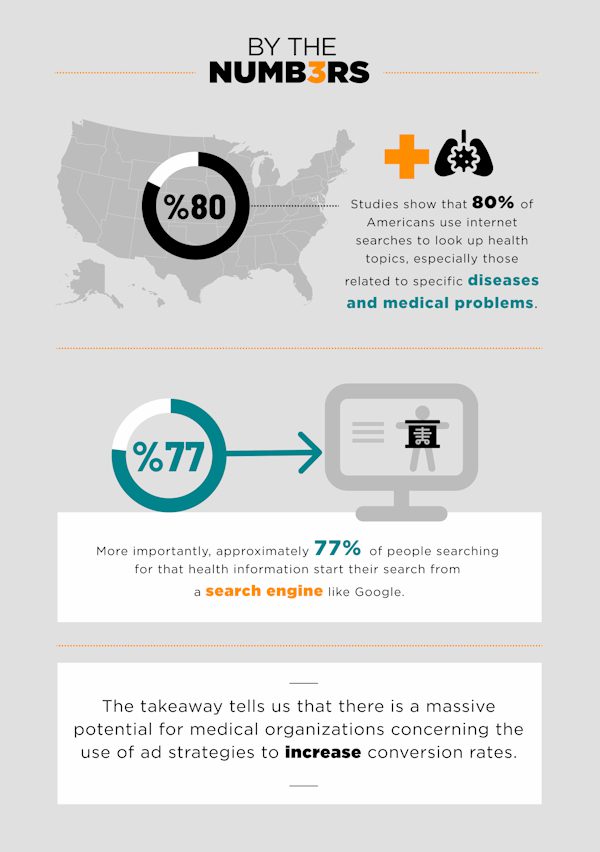Advanced Medical PPC Strategies You Need to Start Now

The average Cost-per-Acquisition (CPA) across all industries is sitting at $48.96. The medical industry comes in at a whopping $78.09. Even if you are already running Pay-per-Click (PPC) marketing campaigns for your medical company, there are a number of advanced PPC strategies to pull from.
These strategies can significantly improve crucial metrics such as your CPA and Return on Ad Spend (ROAS). Mainly, it can lead to more sales for your medical company.
By The Numbers
Studies show that 80% of Americans use internet searches to look up health topics, especially those related to specific diseases and medical problems.
More importantly, approximately 77% of people searching for that health information start their search from a search engine like Google. The takeaway tells us that there is a massive potential for medical organizations concerning the use of ad strategies to increase conversion rates.
However, the truth of the matter is that there is still much that medical companies can put in place to generate increased leads for a remarkable Return on Investment (ROI). Let’s dive into PPC strategies and PPC best practices you can implement to take your brand to the next level.
Make the Best Out Of Ad Extensions
One of the ad strategies your company can maximize to increase conversion rates is ad extensions.
If you have already have considered ad extensions, there are multiple types that you may not have known existed that can accelerate ideal actions (such as clicks and purchases) from your customers:
- Automated Call or Message
- Dynamic Callout
- Dynamic Structured Snippet
- Seller Ratings
- Affiliate Location
Employ Dynamic Search Advertisement
Healthcare is not a straightforward industry when it comes to online searches. That means it might be difficult for users to precisely describe what they feel regarding sickness. This can prove to be a big roadblock in terms of finding your target audience.

The good news is that dynamic search ads (DSAs) come in handy to solve this marketing dilemma, and you likely have already been putting them to use. Consider these more advanced approaches for getting the most out of your dynamic searches.
Target By Specific Web Pages
Since Google defaults DSA ad groups by category based on their recommendation, these preset categories often don’t give you much flexibility in terms of analyzing with the granularity you’d like.
A solution to this is to target by your web pages. For example, if you sell coffee beans and coffee accessories, you could target your web page URLs categorized by those with “accessories” in the URL slug to isolate only those pages. This allows you to adjust your bids more effectively if the default grouping by category isn’t working well for you.
Creating Custom Feeds
Custom page feeds in Google allow you to organize your URLs and rearrange them based on labels. This provides an unprecedented level of specificity. For example, label your URLs by:
- Location
- Medical professional
- Specialization (Hands, ENT, etc.)
- Category
- Single-service or multiple offerings (insurance packages versus single-policy)
Monitor Your DSA
There are a few ways to optimize your Dynamic Search Ads once you’ve implemented custom feeds with labels:
- Exclude labels with low ROAS
- Check on your search term reports and get rid of irrelevant keywords
- Lower your bid on labels with search terms that are too vague, broad, or costing you too much
Use the Store Visits Metric
In case you operate as a brick-and-mortar institution, Google has implemented the Store Visits metric to help track foot traffic to your store. Physical locations are often overshadowed by the robust PPC’s, CTR’s, CPM’s, and CPC’s of their digital counterparts.
Store Visits gathers its data through scraping Google Earth, as well as Google Street Maps, GPS, and visit behavior. It uses that aggregated data to provide a reliable estimate as to how many customers are visiting your stores. What’s more, Google is currently testing Bluetooth-Low-Energy (BLE) devices to better track analytics and visits in-store.
You can take advantage of the Store Visits metric from Google. First, be sure to have multiple stores in an eligible country like the U.S.A. Then, enable location extensions, and have your My Business account linked to your Google Ads account.
One use case from Google on store visits shows Nissan UK upping their ROI by 25% through using Store Visits metrics to choose which campaigns motivated people the most to visit their local dealership. Considering that in 2019 the average car shopper visited a dealership only 2.3 times before making a purchase (down from 2.7 in 2017), that’s an incredible outcome for Nissan using the Store Visits metric.

Smart Display
As an effective marketer in the medical industry, try these strategies with your Smart Display campaigns:
- Use ads appropriate to the times: This may be a no-brainer, but it is worth mentioning. Some ads that previously performed well may no longer be appropriate, such as large groups or international advertising. Consider replacing them in favor of virtual occasions or schedules by appointment only.
- Increase Ad Budget Incrementally: Anything below 10% or above 25% in ad spend increase at any one time is likely to compromise the quality of your data collection.
- Try Standard Campaigns: For access to negative keywords lists, device targeting, and delivery method, try standard campaigns instead for greater customization.
Other Advanced PPC Strategies to Try
Finally, consider these other advanced PPC strategies to increase your bottom line:
- Gmail Sponsored Promotions: Leverage existing email marketing campaign data with Gmail Sponsored Promotions (GSPs) for better-performing ads.
- In-Market Audiences: Optimize your use of in-market audiences to target specific users who are taking the actions you’re looking for: buying behaviors such as clicking on ads and converting on your landing pages.
- Competitive search terms: Bid on the search terms of your competition and make yourself known to customers who are likely to use your services since they’re using those of others in your industry.
When well-monitored, adjusted, and employed on a consistent basis, these advanced PPC strategies can attract more users to your products and services.
Do you need someone to help you achieve your growth goals - then let us help you crush them? Let's chat!
Error: Contact form not found.











